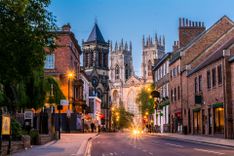1. Alnwick Castle, Northumberland
Alnwick Castle is one of the most impressive castles in England, with a history that stretches back over 900 years. Still home to the Percy family, the Dukes of Northumberland, it has played a central role in centuries of power struggles, political deals, and royal visits. Inside, you’ll find grand state rooms, fine art, and medieval architecture that’s remarkably well preserved.
Outside, the sweeping grounds and formal gardens are just as striking. For many visitors, though, it’s the castle’s role as Hogwarts in the Harry Potter films that steals the show. You can even take a broomstick training session in the same courtyard where Harry first learned to fly.
If you're hunting for the best places to visit in England, this castle ticks all the boxes: history, scenery, and pop culture rolled into one. It’s also a top pick if you’re exploring England with kids; there’s just enough magic and medieval drama to keep everyone entertained.
How to get to Alnwick Castle
From London or Edinburgh, take a train to Alnmouth (3 hours from London, 1 hour from Edinburgh), then a 10-minute taxi or X20/X18 bus to the castle.
When to visit Alnwick Castle
Open from late March to October. July and August are busiest, but May or September offer fewer crowds and milder weather.
























